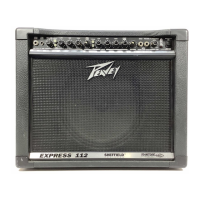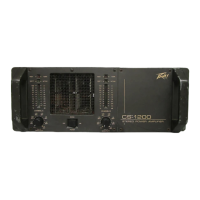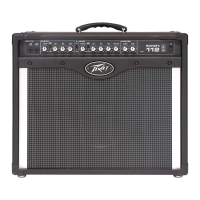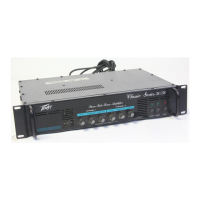Escort
®
のセットアップは、他のサウンドシステムのセットアップと似ており、一般常識を要する部分が多くあります。常に安全を第一に
考えてください。コンセントは常に接地し、3線の延長コードを使用してください。危険な状態や転倒を防ぐようにサウンドシステムの
ケーブルを配線し、必要に応じて固定します。スピーカースタンドとミキサーを、表面が平らで安定した場所に置きます。このガイドラ
インを守ることで、人身の障害や機器の破損を防ぎ、製品を故障なく長く使用することができます。
安全第一!
セットアップガイド
ミキサーとスピーカーのセットアップ
スピーカーが上側に来るように本体をセットします。ラッチが外れるまで持ち上げてラッチを解除します。スピーカーをケースから取り出しま
す。
注:スピーカーを取り外すとラッチがかかります。これは他のコンポーネントの取り外しの邪魔になるのを防ぐためです。またラッチの破損を防
ぐためでもあります。ラッチを閉じるには、ケースの側面に揃うまで押し、固定されるまで押し下げます。
スピーカースタンドをケースから取り出します。スタンドの脚が十分に伸びていて、スピーカーの土台として安定していること、平らな面にあ
ることを確認します。ベースの蝶ネジを締めます。締め付けすぎないように注意してください (図1)。スピーカースタンドを必要な高さまで上
げ、蝶ネジを締め、図のように安全ピンを取り付けます (図2)。
警告! ミキサーには付属のスピーカー以外のスピーカーを接続しな
いでください。Escort スピーカーはパワードミキサーに最適な負荷
に設定してあり、他のスピーカーを使用すると機器が破損することが
あります。
スピーカーをスタンドに置き、聴き手の方を向くように、マイクから離して配置します(図3)。スピーカー下前面にあるジャックからミキサー背
面にあるスピーカー出力にスピーカーケーブルを接続します。左スピーカーは「左出力」に、右スピーカーは「右出力」に接続します(図4)。
図3
図1
図1
7
The FLS
®
(Feedback Locating System) LED indicators are invaluable tools in helping to reduce/eliminate feedback. To
use the FLS feature, start by setting all graphic EQ sliders (Fig. 9) to 0. Then, before the audience arrives, increase the
MASTER VOLUME and/or CHANNEL GAIN until feedback occurs. Note which LED illuminates and slightly lower
the corresponding slider. This reduces the gain at the feedback frequency, and can be repeated if necessary to improve
gain before feedback. However, only lower the sliders in small amounts to avoid adversely affecting sound quality.
Fig. 9
Avoiding Acoustic Feedback
Acoustic feedback is the loud howl or squealing sound heard through sound systems as the result of sound from the
speakers re-entering the microphones. Although it does an excellent job of getting the audience’s attention, feedback
should be avoided. When trying to deal with acoustic feedback it is always best to start looking at the placement of the
mics and speakers in the system before resorting to equalization (EQ) adjustment. Make sure that the speakers are
positioned to direct the sound toward the audience and away from the microphones. Position mics as close to the sound
source as reasonable. Moving the mic closer increases the volume of the sound through the system without having to
turn up the gain.
Microphone Usage Guidelines
When practical, a single microphone is preferred. Additional microphones pick up more sound from the speakers and
each mic has to be turned down a little to prevent feedback. However, if you have difficulty balancing the level of
different individuals with one mic, or if you still cannot get sufficient gain, using more mics can offer an advantage.
Giving several singers their own microphones, for example, allows placement of the microphones much closer to each
singer. This increases the volume of the sound at the mic and far outweighs any detrimental effect from using multiple
mics. It also allows the volume of each mic to be adjusted separately for proper balance.
Reverb
Adding reverberation to music can enhance the sound of that music. To add reverb to a microphone, simply turn up the
REVERB control (Fig. 7) on the appropriate input channel. Add reverb in moderation because too much reverb makes
vocals hard to understand. In most cases, it is best not to add reverb to the spoken word.
Stereo / Mono Operation
The Escort
™
2000 powered mixer has two input channels (4 & 5) for stereo line sources. If the speakers are situated so
that most of the audience can hear both speakers (Fig. 10 A), it can be advantageous to run the system in stereo. If the
audience primarily hears just one speaker (Fig. 10 B), or if you are using one speaker for the audience and the other for
the stage performers, then it is best to run the system in mono.
Fig. 10
Stereo
Mono
Stereo
Mono
A B
7
The FLS
®
(Feedback Locating System) LED indicators are invaluable tools in helping to reduce/eliminate feedback. To
use the FLS feature, start by setting all graphic EQ sliders (Fig. 9) to 0. Then, before the audience arrives, increase the
MASTER VOLUME and/or CHANNEL GAIN until feedback occurs. Note which LED illuminates and slightly lower
the corresponding slider. This reduces the gain at the feedback frequency, and can be repeated if necessary to improve
gain before feedback. However, only lower the sliders in small amounts to avoid adversely affecting sound quality.
Fig. 9
Avoiding Acoustic Feedback
Acoustic feedback is the loud howl or squealing sound heard through sound systems as the result of sound from the
speakers re-entering the microphones. Although it does an excellent job of getting the audience’s attention, feedback
should be avoided. When trying to deal with acoustic feedback it is always best to start looking at the placement of the
mics and speakers in the system before resorting to equalization (EQ) adjustment. Make sure that the speakers are
positioned to direct the sound toward the audience and away from the microphones. Position mics as close to the sound
source as reasonable. Moving the mic closer increases the volume of the sound through the system without having to
turn up the gain.
Microphone Usage Guidelines
When practical, a single microphone is preferred. Additional microphones pick up more sound from the speakers and
each mic has to be turned down a little to prevent feedback. However, if you have difficulty balancing the level of
different individuals with one mic, or if you still cannot get sufficient gain, using more mics can offer an advantage.
Giving several singers their own microphones, for example, allows placement of the microphones much closer to each
singer. This increases the volume of the sound at the mic and far outweighs any detrimental effect from using multiple
mics. It also allows the volume of each mic to be adjusted separately for proper balance.
Reverb
Adding reverberation to music can enhance the sound of that music. To add reverb to a microphone, simply turn up the
REVERB control (Fig. 7) on the appropriate input channel. Add reverb in moderation because too much reverb makes
vocals hard to understand. In most cases, it is best not to add reverb to the spoken word.
Stereo / Mono Operation
The Escort
™
2000 powered mixer has two input channels (4 & 5) for stereo line sources. If the speakers are situated so
that most of the audience can hear both speakers (Fig. 10 A), it can be advantageous to run the system in stereo. If the
audience primarily hears just one speaker (Fig. 10 B), or if you are using one speaker for the audience and the other for
the stage performers, then it is best to run the system in mono.
Fig. 10
Stereo
Mono
Stereo
Mono
A B
または
スピーカージャックをここ
に差し込む
図4
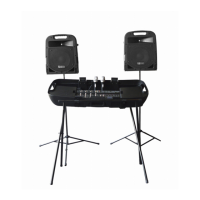
